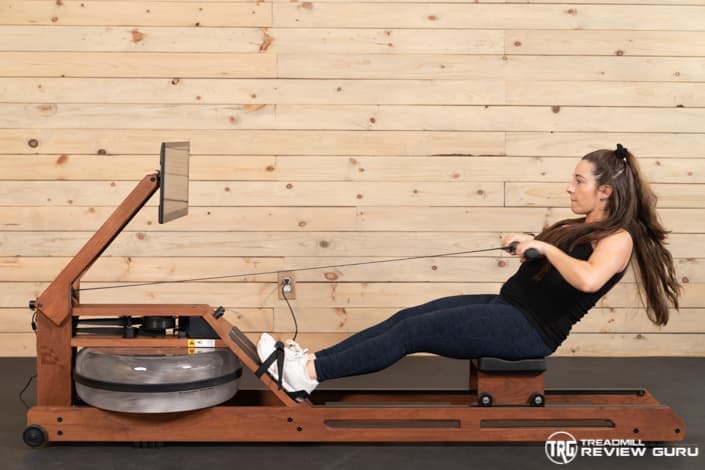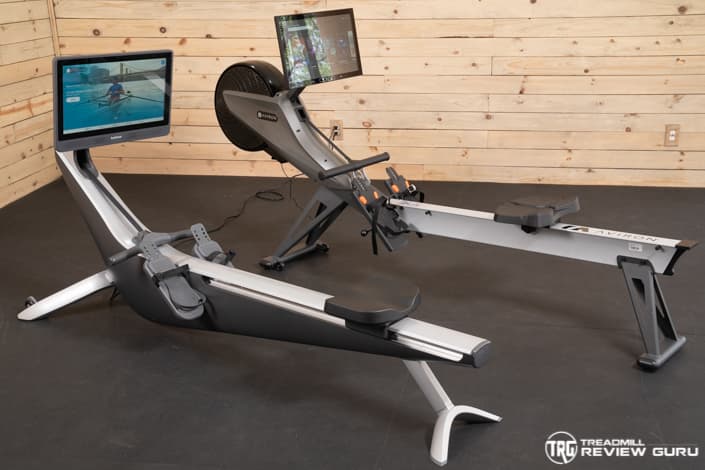Rowing is a great cardio workout that also helps build strength while being low-impact which protects the joints. With plenty of rowers available on the market, you can enjoy rowing in the comfort of your own home. But what type of rower is best for your home gym?
There are 4 different types of rowing machines for your home gym to choose from. These include water rowers, air rowers, magnetic rowers, and hydraulic rowers. Each of these has different means for resistance as well as advantages and disadvantages when using them at home.
For even more information on the different brands that we recommend, check out our Best Rowers list to find the perfect rowing machine for your home.
Water Rowers

The clear tank on the Ergatta Rower is filled with water and the paddles move through the water as you row.
Water rowers use- you guessed it- water to provide resistance to row against. This type of rower most simulates rowing on a boat with the way the paddles push against the water. While they can be a splurge, something to consider is that they are pretty quiet. The sloshing of water is typically the only sound that comes from it, and most people like the noise.
The faster you row, the more resistance you get from the water. However, the resistance levels for water rowers aren’t adjustable like other rowers. Instead, you can add more water to the tank to make the strokes feel heavier and to get a bit more tension. Alternatively, the strokes will feel lighter if you remove some of the water.
Pros and Cons of Water Rowing Machines
- Quiet (most actually like the noise from the water)
- Smooth and consistent stroke
- Feels like rowing on water
- Resistance is increased as you pull faster and harder
- Large footprint and most don’t fold
- Priced on the higher-end of other rowers
- Water has to be changed sometimes (unless yours comes with tablets to clean the water) and the tank has to be filled during setup
Air Rowers
Similar to water rowers, the harder and faster you row on an air rower, the more tension you will get. As the flywheel spins, air is sucked in and used as a force against the flywheel to create resistance. Dampers are often used to change the feel and tension of the stroke as well.
Air rowers, or flywheel rowers as they are also referred to as, are the most popular and are often preferred because of their ability to handle unlimited resistance for any amount of strength. Air rowers have smooth, natural feeling strokes, but are quite loud so if noise is an issue, this is definitely something to consider.
Pros and Cons of Air Rowing Machines
- Natural and smooth feel while rowing
- Unlimited resistance
- Popular
- Requires little to no maintenance
- Larger footprint (long)
- Louder than other rowers

The Hydrow (left) and Aviron (right) have different designs but they’re both solid rowers.
Magnetic Rowers
Magnetic rowers have a flywheel that works against a magnetic brake. The resistance is constant, so it won’t change when you pull harder and faster. The tension can be changed however, and most models, like the Hydrow, have a wide range of resistance.
The tension isn’t as strong as air or water rowers, but it is the quietest out of all the other types of rowers. Some are even silent.
Pros and Cons of Magnetic Rowing Machines
- Very quiet
- Smaller than other rowers (many fold and are lightweight)
- Resistance is adjustable and offers a wide range
- Low maintenance
- Doesn’t provide a realistic rowing feel
- Cheaper models with lighter flywheels aren’t as smooth
Note: Although they are on the pricier side, some rowers have both magnetic and air resistance which allows for an even wider range of tension to pull against.
Hydraulic Rowers
Hydraulic rowers work by pulling a lever that is attached to the piston. They are typically pretty small and more affordable when compared to the other kinds of rowers.
The bars on hydraulic rowers limit you in the direction you can pull, unlike other rowers with handles that are attached to chains or strings. Most of these rowers have fixed seats where your legs don’t move, so you won’t get the same full-body workout as the other rowing machines.
Pros and Cons of Hydraulic Rowers
- The smallest type of rower and most fold up
- Affordable
- Quieter than air rowers
- Most models aren’t the smoothest
- Requires regular maintenance
- Provides less of a full-body workout than other rowers
- Doesn’t give a realistic row experience like other rowers
- Can change resistance but not while using the machine
The Best Type of Rower For Your Home Gym
As you can see, there are upsides and downsides to each of the rowers for home use. Before you purchase a rower for yourself, you should consider the following factors. One is, how big is your space? While some rowers do fold, a lot do not and have a large footprint.
Another big aspect is noise. If you’re in an apartment, an air rower might be too noisy. Also, if you have hard floors, you might want to get a mat to put under the rower to prevent any damage to your floor or the machine and to keep the machine from moving. You can check out the best home gym flooring to see which flooring is best for your rower.
Budget may be a factor too, and of course you should think about your fitness goals and what you want out of your rower. What kind of experience do you want? Do you want the rowing to feel realistic, or are you just looking for a good workout?
What about tech? Do you want a more immersive experience with a large screen and plenty of content? Or are you looking for a more basic console? What about a subscription to classes? There are plenty of options, so rest assured there is a rower out there for you.
Be sure to check out more from us here, and let us know in the comments below what type of rower you like best. We’d love to hear from you.


Leave a Reply